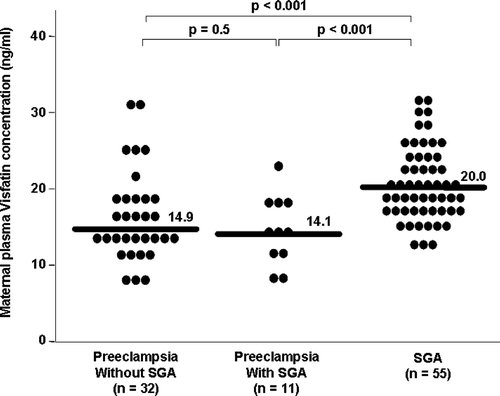Figures & data
Table I. Clinical and demographic characteristics of the study population.
Figure 1. Maternal plasma visfatin concentration in normal pregnant women, patients with preeclampsia and patients who delivered an SGA neonate. The median maternal plasma concentration of visfatin was significantly higher in patients with an SGA neonate than in those with either a normal pregnancy (20.0 ng/ml, interquartile range [IQR]: 17.2–24.6 vs. 15.2 ng/ml, IQR: 12.1–19.2, respectively; P < 0.001) or those with preeclampsia (14.5 ng/ml, IQR: 12.5–18.7; P < 0.001). The median maternal plasma visfatin concentration did not differ significantly between patients with preeclampsia and those with a normal pregnancy (P = 0.8).
![Figure 1. Maternal plasma visfatin concentration in normal pregnant women, patients with preeclampsia and patients who delivered an SGA neonate. The median maternal plasma concentration of visfatin was significantly higher in patients with an SGA neonate than in those with either a normal pregnancy (20.0 ng/ml, interquartile range [IQR]: 17.2–24.6 vs. 15.2 ng/ml, IQR: 12.1–19.2, respectively; P < 0.001) or those with preeclampsia (14.5 ng/ml, IQR: 12.5–18.7; P < 0.001). The median maternal plasma visfatin concentration did not differ significantly between patients with preeclampsia and those with a normal pregnancy (P = 0.8).](/cms/asset/2eaca8ed-87e9-480e-9bea-db9367a5b86e/ijmf_a_430275_f0001_b.gif)
Figure 2. Maternal plasma visfatin concentration in patients with preeclampsia who delivered an SGA neonate, patients with preeclampsia who delivered an AGA neonate and patients without preeclampsia who delivered an SGA neonate. Among patients with preeclampsia, there was no significant difference in the median maternal plasma visfatin concentration between those with and without an SGA neonate (14.1 ng/ml, IQR: 11.8–17.5 vs. 14.9 ng/ml, IQR: 12.8–19.0, respectively; P = 0.5). The median maternal plasma concentrations of visfatin were significantly higher in patients with an isolated SGA neonate than in those with preeclampsia either with or without an SGA neonate (P < 0.001 for both comparisons).

